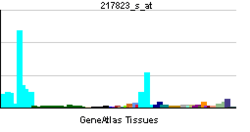UBE2J1
| View/Edit Human | View/Edit Mouse |
Ubiquitin-conjugating enzyme E2 J1 is a protein that in humans is encoded by the UBE2J1 gene.[3][4]
The modification of proteins with ubiquitin is an important cellular mechanism for targeting abnormal or short-lived proteins for degradation. Ubiquitination involves at least three classes of enzymes: ubiquitin-activating enzymes, or E1s, ubiquitin-conjugating enzymes, or E2s, and ubiquitin-protein ligases, or E3s. This gene encodes a member of the E2 ubiquitin-conjugating enzyme family. This enzyme is located in the membrane of the endoplasmic reticulum (ER) and may contribute to quality control ER-associated degradation by the ubiquitin-proteasome system.[4]
References
- ↑ "Human PubMed Reference:".
- ↑ "Mouse PubMed Reference:".
- ↑ Lester D, Farquharson C, Russell G, Houston B (Apr 2000). "Identification of a family of noncanonical ubiquitin-conjugating enzymes structurally related to yeast UBC6". Biochem Biophys Res Commun. 269 (2): 474–80. doi:10.1006/bbrc.2000.2302. PMID 10708578.
- 1 2 "Entrez Gene: UBE2J1 ubiquitin-conjugating enzyme E2, J1 (UBC6 homolog, yeast)".
Further reading
- Maruyama K, Sugano S (1994). "Oligo-capping: a simple method to replace the cap structure of eukaryotic mRNAs with oligoribonucleotides". Gene. 138 (1–2): 171–4. doi:10.1016/0378-1119(94)90802-8. PMID 8125298.
- Suzuki Y, Yoshitomo-Nakagawa K, Maruyama K, et al. (1997). "Construction and characterization of a full length-enriched and a 5'-end-enriched cDNA library". Gene. 200 (1–2): 149–56. doi:10.1016/S0378-1119(97)00411-3. PMID 9373149.
- Lai CH, Chou CY, Ch'ang LY, et al. (2000). "Identification of Novel Human Genes Evolutionarily Conserved in Caenorhabditis elegans by Comparative Proteomics". Genome Res. 10 (5): 703–13. doi:10.1101/gr.10.5.703. PMC 310876
 . PMID 10810093.
. PMID 10810093. - Zhang QH, Ye M, Wu XY, et al. (2001). "Cloning and Functional Analysis of cDNAs with Open Reading Frames for 300 Previously Undefined Genes Expressed in CD34+ Hematopoietic Stem/Progenitor Cells". Genome Res. 10 (10): 1546–60. doi:10.1101/gr.140200. PMC 310934
 . PMID 11042152.
. PMID 11042152. - Lenk U, Yu H, Walter J, et al. (2002). "A role for mammalian Ubc6 homologues in ER-associated protein degradation". J. Cell. Sci. 115 (Pt 14): 3007–14. PMID 12082160.
- Strausberg RL, Feingold EA, Grouse LH, et al. (2003). "Generation and initial analysis of more than 15,000 full-length human and mouse cDNA sequences". Proc. Natl. Acad. Sci. U.S.A. 99 (26): 16899–903. doi:10.1073/pnas.242603899. PMC 139241
 . PMID 12477932.
. PMID 12477932. - Mungall AJ, Palmer SA, Sims SK, et al. (2003). "The DNA sequence and analysis of human chromosome 6". Nature. 425 (6960): 805–11. doi:10.1038/nature02055. PMID 14574404.
- Gerhard DS, Wagner L, Feingold EA, et al. (2004). "The Status, Quality, and Expansion of the NIH Full-Length cDNA Project: The Mammalian Gene Collection (MGC)". Genome Res. 14 (10B): 2121–7. doi:10.1101/gr.2596504. PMC 528928
 . PMID 15489334.
. PMID 15489334. - Wu CJ, Conze DB, Li X, et al. (2005). "TNF-α induced c-IAP1/TRAF2 complex translocation to a Ubc6-containing compartment and TRAF2 ubiquitination". EMBO J. 24 (10): 1886–98. doi:10.1038/sj.emboj.7600649. PMC 1142588
 . PMID 15861135.
. PMID 15861135. - Oh RS, Bai X, Rommens JM (2006). "Human homologs of Ubc6p ubiquitin-conjugating enzyme and phosphorylation of HsUbc6e in response to endoplasmic reticulum stress". J. Biol. Chem. 281 (30): 21480–90. doi:10.1074/jbc.M601843200. PMID 16720581.
This article is issued from Wikipedia - version of the 6/4/2016. The text is available under the Creative Commons Attribution/Share Alike but additional terms may apply for the media files.


